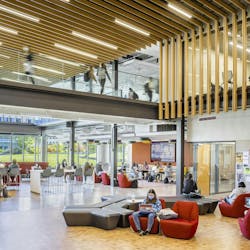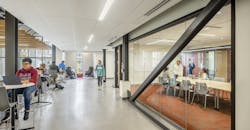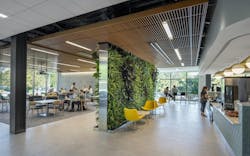Student life design impacts campus wellness
As interior designers, we have the opportunity and responsibility to help students achieve deeper levels of engagement in their learning, social involvement, and personal growth on college campuses. While the college campus is a place for discovery, attracting students of all ages and backgrounds to learn, connect and explore, it can also be a place that is competitively charged, socially intimidating and isolating. Campuses need to be welcoming and approachable, supporting the community’s overall well-being in addition to their education. A student’s ability to learn and be receptive to growth can be rooted in their sense of comfort in their physical environment. We cannot reach our fullest potential if we do not feel like or bring our best selves with us. While every college requires a personalized solution, we’ve identified three design elements that have an overwhelming benefit to student well-being and success:
- Transitional spaces
- Restorative qualities
- Healthier materials
Transitional spaces
It’s not just the classrooms that fuel the student experience, the journey is as important as the destination. Transitional spaces connect destinations, supporting secondary activities and students with neurodiverse needs. Those “in between” spaces – touch down areas, breakout spaces and informal seating niches – are equally important in allowing students to pause between movements, collect their thoughts or simply breathe.
As designers, we can alleviate the stress of campus navigation through intuitive wayfinding, zones for activity transitions and layering programmatic spaces that provide a diversity of seating and experiences. At the University of Massachusetts (UMass) Amherst Student Union Renovation, spaces outside the meeting rooms were prioritized just as much as the meeting rooms itself. Areas for a quick sit or a long lounge near a window, layered in front of more activity driven spaces, allow students to occupy the in between areas and have the time to transition to student activity.
Restorative qualities
Just as campus cultures vary, restoration can be defined in a variety of ways by individual communities. While connection to nature and natural daylight are common desires, some times restoration is achieved through reflection and prayer, other times through play or creative pursuits. Spaces designed to recharge allow students, faculty, and staff to stay engaged in their college community and connect with each other around non-academic interests.
For some students, heavy workloads, emotionally challenging situations and separation from family can lead to unhealthy lifestyles and mental states. Spaces can provide a variety of resources and spaces for formal student engagement by day, converting to informal relaxation and restoration zones by night. There are huddle rooms for work or gaming, quiet areas for studying or napping, and community areas for sharing and generating ideas. For other institutions, relaxation comes in the form of creative pursuits. Our robust community engagement process for a new student center at Johns Hopkins University revealed that the student body sought more creative outlets like art, dance, and music outside of their rigorous academic schedules. At Wabash College, located in a small Indiana town, students come together around games, and wanted a place to go out on campus.
Healthier materials
The interior environment impacts our health, wellbeing, and cognitive performance. As part of sustainable goals, we identify healthier interior material and furniture requirements that will provide physical and psychological benefits for students and staff. Avoiding chemicals of concern in our interior finishes and furniture improves indoor air quality and reduces physical exposure to building occupants. Furthermore, biophilic design connects people and the natural world, creating impactful ways to nurture the mind and soul. This includes exposure to views of nature, natural daylight, as well as organic inspired color palettes and elements. Textured materials, such as wood, stone, perforated metal, and fabrics, bring a richness to the interior environment.
At Loyola University, we designed a café on the first level with a vibrant living wall that gave space for students to relax and connect on campus outside of learning, the career center, or entrepreneurial activities that brought them to the building. Wood tones and materials were selected with the landscape palette in mind, looking at Loyola through the seasons. Biophilic inspired carpets reiterated the natural textures outside the building while contrast levels of lighting gave places for the eyes to rest. Offices kept in a similar palette to let the daylight and views of the campus greenery serve as the backdrop to the space.
There are so many ways we can further the future of student life and success to ensure spaces evolve with what is needed for comfort and productivity. Health impacts our everyday functions and the ability for both students and faculty to learn – spaces should be designed to promote the value of caring for our physical and mental well-being.
About the Author
Shepley Bulfinch
Shepley Bulfinch is a national architecture and design firm with studios in Boston, Durham, Hartford, Houston, and Phoenix. Founded in 1874, the firm has a notable legacy of challenging convention, pioneering visionary design ideas, and collaborating with clients who seek to drive measurable change. Shepley Bulfinch architects and designers are regarded for their expertise in tackling complex projects, especially in the areas of education, healthcare, and urban development. For more, visit our website or follow us on Facebook, LinkedIn, and Twitter.



